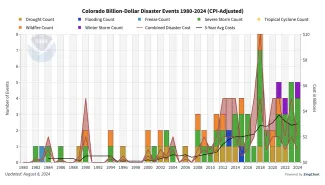
Aspen to Springfield: These far-apart Colorado towns share electrical vulnerabilities
© zhaojiankang - iStock-802436842
(Colorado Newsline) Springfield and Aspen have almost nothing in common other than being county seats in Colorado. They also happen to be in electrical cul-de-sacs, at the end of transmission lines.
Microgrids may help both in their relative electric isolation.
Aspen, of course, has a mountain backdrop that inspires calendar photographers and has several dozen billionaires among its residents. It also has daily plane service for those who can’t afford their own jets. Thinkers from around the globe gather to puzzle through the world’s problems. It’s a small town unlike nearly all others on the planet.

Springfield is a more humble place, its scenery esoteric, its economy more sketchy, with the most productive farms dependent on the declining Ogallala and other aquifers. Oklahoma lies a half-hour south, Kansas just a bit farther east. There’s just one real restaurant, and it goes dark after 2 p.m. on Sunday, remaining so until Tuesday morning.
Both places have gone dark in the past when transmission has been disrupted. Might microgrids help soften the isolation?
A new round of state grants is helping Springfield and others plan microgrids. Other microgrids were created without state aid.
Aspen came close to going dark on its very busy Fourth of July weekend in 2018. The Lake Christine wildfire had started burning one of the transmission poles that delivers electricity from the lower Roaring Fork Valley. Had firefighters arrived just a little later, Aspen might have been un-electrified on one of its busiest weekends.
A microgrid nearing completion will not keep Aspen fully electrified if something similar happens, but a few core functions will continue to get power.
The site is located along Highway 82 near the Aspen-Pitkin County Airport, adjacent to the Pitkin County public works headquarters and a bus barn for Roaring Fork Transit.
Concrete foundations have been poured and two batteries the size of shipping containers were to arrive this month and be installed this autumn. They were ordered in June 2023. Switching and communication control equipment that will pilot the system won’t be operational until the middle of 2025.
Gerald Fielding, a Pitkin County engineer, describes this microgrid as a little island. It will have maximum electricity consumption at the airport and the two other facilities for two hours — longer yet, if some demands can be shaved. None of this includes electric charging of buses.
The airport already has backup electricity via a natural gas generator, as required by the Federal Aviation Administration. These batteries will provide a secondary and non-fossil fuel backup.
Batteries aren’t just for emergencies, though. The microgrid will be managed by Holy Cross Energy, an electrical cooperative whose service territory includes about half of Aspen and the rest of the Roaring Fork Valley. The batteries should be drained twice a month, and Holy Cross can incorporate their capacity into its operations.
Unlike Denver, which has peak demand on a summer afternoon or evening, Aspen and Vail’s demands peak during winter evenings.
If transmission to the upper Roaring Fork Valley were disrupted, how would this microgrid help? Not much. The batteries will have sufficient capacity to satisfy just 2.9% of the total peak winter demand for the Aspen area. That includes downtown Aspen, which is served by the municipal electricity provider.
To be able to provide a complete backup for all maximum power needs in the upper Roaring Fork would require far more investment. This small island so far costs $3.35 million. To quadruple the batteries and directly tie in production from a 5-megawatt solar project a few miles away would escalate the cost to $25 million.
Ben Luck, a Holy Cross engineer, says because of their great expense, other microgrids in the Holy Cross service territory will likely be community-driven.
“By definition, a microgrid is a large investment that benefits one small part of our system,” he explains. “This project was driven by Pitkin County. We will play a supporting role, but the driving force will have to come from the community to which it will deliver benefits.”
What exactly is a microgrid?
Microgrids have been defined in various ways. A draft microgrid roadmap ordered by Colorado legislators uses a definition with a broad scope. It could include individual buildings, universities or other campuses, even entire communities. Or something in between.
Other definitions use the analogy of an island. In normal times, the island has connections to the mainland, i.e. the broader electrical grid. It can, however, function solo.
“A microgrid can connect and disconnect from the grid to enable it to operate in both grid-connected or island-mode,” according to the U.S. Department of Energy definition.
Microgrids are not particularly new, though. Hospitals and other critical infrastructure have long had backup generators that typically burn diesel or other fuels.
Today’s microgrids hew to this same idea of providing backup power but, with the aid of batteries, can create larger islands.
Interest has been spurred by an uptick in violent weather. Boulder resident Peter Lilienthal, former chief executive at HOMER Energy, a company specializing in microgrids and other electrical innovations, points to Hurricane Sandy in 2012 as a pivotal event.
Lilienthal, speaking on a recent webinar sponsored by Boulder’s Empower Our Future, explained that the multi-day power outages provoked by the hurricane illustrated the need for alternatives when the electric grid goes down.
“You are realizing that it’s not just hospitals that need backup generation,” he said. “Grocery stores and gas stations become critical infrastructure.”
This summer’s Hurricane Beryl seemed to prove the point in Houston. Microgrid Knowledge reported that grocery stores and homes with microgrids weathered outages for more than a week.
“It is past time to start recognizing that the 20th century ‘Big Grid’ model doesn’t work well as weather gets increasingly extreme in the 21st century,” said Boulder’s Leslie Glustrom in passing along the story.
One of the biggest barriers for microgrid development around the country is the challenge of interconnecting multiple customers into a multi-customer community microgrid. That is really where microgrids bring value.
– Cameron Brooks, of Think Microgrid
Interrelated with the rise of microgrids is the growing role of electricity in our lives. If we’re going to ask the grid to deliver power not just for our lights and dishwashers but also to heat our homes and power our cars, we need some backup strategies, right?
Microgrids can be created in densely settled urban areas.
Xcel Energy, for example, is wrapping up completion of six microgrid pilot projects that resulted from 2018 state legislation. Those microgrids seek only to provide backup power for individual buildings.
They have been completed at the Alamosa Recreation Center, the Arvada Center, and Nederland Community Center. One is also planned at the Denver Rescue Mission.
Xcel explains that the sites were selected after communities were encouraged to submit projects that would support facilities they deemed critical in nature. The Arvada Center — a concert and arts venue — was chosen because it was designated as a recovery and shelter hub in the city’s disaster recovery plan.
The calculus for Denver International Airport was a little different. There, the battery system will have 4,500 kWh for the tram that moves passengers between the main terminal and the three concourses.
Rural areas exhibit greater need. For example, Red Feather Lakes, an unincorporated hamlet in the foothills northwest of Fort Collins, has had a small microgrid since 2018 to power crucial services if deliveries from the electric grid get disrupted, as nearly happened during the wildfires of 2020. It has a 140-kW, 447-kWh Tesla Powerpack battery connected to 8 kW of solar photovoltaic and a 130-kW propane generator. That won’t provide power for outlying cabins but does provide power for the volunteer fire department, the community building, post office, area businesses, and other buildings.
Thinking of rural areas
Colorado legislators had rural areas primarily in mind in 2022 when they passed House Bill 22-1013 with strong bipartisan support. Tellingly, the bill used the word “rural” 16 times but urban not once. It says that microgrids can “help increase a community’s resilience regarding severe weather or natural disaster events that can affect the electricity grid by providing the community with an alternative, reliable source of electricity that is not dependent on the electric grid.”
The law ordered a microgrid roadmap but also allocated $3.5 million for seed money for microgrid planning and implementation. The Microgrids for Community Resilience Program recently announced $2 million in grants, including much of the $40,000 that Springfield and its wholesale supplier, Arkansas River Power Authority, will use to explore backup power and microgrid opportunities.
Also included in the July announcement:
- $46,9000 to assist in the installation of a small solar and battery storage system that will provide 1.5 days of backup power at Ridgway.
- $350,000 to the Platte River Power Authority for 5-megawatt, 20-megawatt-hour battery installation at Estes Park.
- $700,000 to United Power, an electrical cooperative that serves a broad swath of northern Colorado, for batteries at four fire stations in its service territory.
- $900,000 to Poudre Valley Rural Electric Association for installation of 350-kW and 1,200-kWh batteries and microgrid controller in Livermore. The hamlet is located on Highway 287 — yes the same highway that gives Springfield its main street — between Fort Collins and Laramie, Wyo.
“The Livermore microgrid will create another resiliency hub at the local school, fire department, convenience store, and other essential infrastructure locations,” explained Jeff Wadsworth, the chief executive of Poudre Valley REA.
Wadsworth said Poudre Valley is studying another location in its service territory, this one along U.S. 36 in the Big Thompson Canyon area between Loveland and Estes Park. That work in the Pinewood Springs area would be the result of a direct Congressional allocation sponsored by both of Colorado’s U.S. senators.
Grants previously were delivered to:
- CORE Electric Cooperative for a microgrid project at Bergen Park, in the foothills southwest of Denver
- San Isabel Electric Association for a project in the Beulah and Gardner areas of the southern Front Range
- San Miguel Power Association for two communications sites in Montrose County
- a microgrid in Delta
- another project in Ridgway
Electrical cooperatives, as the state law suggested was necessary, are getting the bulk of grants. The program was abetted by $10.3 million in federal money received by Colorado in 2023.
The remaining $17.2 million in federal money will be allocated to grid-hardening for small communities, advanced grid-monitoring, and preparing the Colorado Microgrid Roadmap.
The roadmap must guide how microgrids may be used to harden the grid, improve grid resilience and reliability, and deliver electricity where extending distribution infrastructure — think power lines and maybe substations — may not be practical.
Public meetings to develop that roadmap have been conducted via webinars since February. The Colorado Energy Office hopes to have it wrapped up by December, several months ahead of the deadline specified by legislators. At least one microgrid expert thinks the roadmap needs a lot of work before it is completed.

©
Drawing on data from federal agencies, the draft Colorado microgrid roadmap has this graphic showing a general increase in expensive weather-related disasters since 1980.Microgrids and electric cul-de-sacs
Extreme weather has been emphasized in the draft roadmap. It cites the National Centers for Environmental Information in reporting that Colorado has had 70 confirmed weather/climate events since 1980 with economic losses exceeding $1 billion. The draft emphasizes functionality of the “small network of interconnected electrical components … when necessary, such as during extreme weather events.”
Transmission lines can be vulnerable to extreme heat, cold and wildfire. Renewable energy resources can also be weather-dependent.
In addition to more climate-driven natural disasters, the roadmap points to social vulnerabilities, places where populations are particularly susceptible to the impacts of outages.
Five distinct regions with the highest combined vulnerabilities and risk attributes are identified in the draft roadmap. The regions cover parts of 19 of Colorado’s 64 counties and have 10% of the state’s population:
- Pueblo, Las Animas, Bent, and Otero
- Alamosa, Conejos, Costilla, Rio Grande, and Saguache
- Archuleta, Dolores, La Plata, Montezuma, and San Miguel
- Mesa, Moffat, and Rio Blanco
- Lake and Grand
The state’s microgrid roadmap
Cameron Brooks has been monitoring the creation of the roadmap. At one time he lived in Ophir, a town of 181 humans and 51 dogs, according to the municipal website.
It might be viewed as a suburb of Telluride, but the context is the San Juan Mountains. It’s 11 miles away but 25 minutes of driving.
Along the way is the hydroelectric plant, which was one of — if not the — first commercial systems to produce and transmit electricity for industrial uses using alternating current. Beginning operations in 1891, it was a triumph for the AC technology advocated by George Westinghouse (and Nicholas Tesla).
Ophir is like Springfield in that there’s just one power line to the town (although a transmission line passes overhead on the way to Ophir Pass and then Silverton).
Now located in Boulder, Brooks directs Think Microgrid, an advocacy group launched in 2021 that seeks to serve as the unified voice for the microgrid industry.
“The technology has advanced a lot in the last 5, 10, to 15 years to the place where things that might have been more aspirational are now technically very viable,” he said.
Brooks calls the draft a “good resource; It feels like a good primer on microgrids here in Colorado.”
However, it falls short in identifying the solutions to the economic and policy barriers that make it very difficult to properly value microgrids in Colorado. And he contends Colorado’s draft microgrid roadmap should better identify needed changes.
“One of the biggest barriers for microgrid development around the country is the challenge of interconnecting multiple customers into a multi-customer community microgrid. That is really where microgrids bring value,” said Brooks.
“The roadmap suggests that is a challenge, but it does not suggest any kind of pathway.”
Colorado’s draft microgrid should explore more deeply what has been done elsewhere, said Brooks. He cited work in Maine, which has addressed the issue of right-of-way restrictions. In Michigan, Ann Arbor has a structure for establishing a supplemental energy utility.
“The easiest example is a shared battery,” that can be shared by four or five homes or businesses, Brooks explained.
Like Lilienthal, Brooks sees hurricanes and tropical storms as delivering a clear understanding of why microgrids should be assigned more value.
“It’s kind of astounding how we as a society give a collective shrug to millions of people losing power,” he said. “If it’s true that storms are getting more powerful, it’s not as though they are unknown things.”
Colorado doesn’t have hurricanes, but it has wildfires. Xcel Energy is proposing a $1.9 billion wildfire mitigation plan. Xcel’s plan, he said, lacks the best available technology.
Microgrids don’t seem to be part of that strategy in any way.
In this view, islands both large and small provide the best option.
Colorado Newsline is part of States Newsroom, a nonprofit news network supported by grants and a coalition of donors as a 501c(3) public charity. Colorado Newsline maintains editorial independence. Contact Editor Quentin Young for questions: info@coloradonewsline.com. Follow Colorado Newsline on Facebook and X.

















